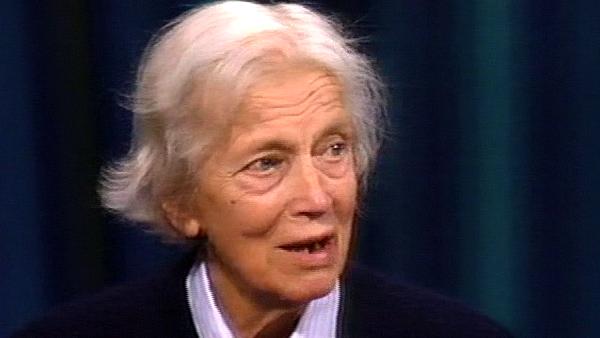NEXT STORY

Thomas Hodgkin's family history
RELATED STORIES

NEXT STORY

Thomas Hodgkin's family history
RELATED STORIES



|
Views | Duration | |
|---|---|---|---|
| 1. Developing an early interest in science | 2 | 2071 | 03:11 |
| 2. Panning for gold in our back garden | 1 | 325 | 03:08 |
| 3. Family history and school | 1 | 400 | 03:17 |
| 4. A rather rackety childhood | 322 | 02:10 | |
| 5. Preparing to get into Oxford | 273 | 02:07 | |
| 6. The mosaic pavements of Jerash | 283 | 05:02 | |
| 7. Thomas Hodgkin's family history | 388 | 01:16 | |
| 8. How I met my husband, Thomas Hodgkin | 302 | 05:53 | |
| 9. Coping with children and research | 352 | 01:34 | |
| 10. Career advice from Sir Charles Harington | 250 | 00:51 |

He was supposed to retire from Sudan in 1926 which was rather early it seems, but this was because it was deemed an unsatisfactory kind of climate for Brits to stay too long in, so he came home in '26 and then he really wanted a job still, and he cast around. The job he got... that he got offered was the director of the British School of Archaeology in Jerusalem, and this pleased him a great deal because he had had a scholarship when young to work in the Middle East on Byzantine churches and then, in 1926, it was obvious he could take up that work that happened long ago again. The British school had one disadvantage which was that it was a very poor institution so that, if one wanted to do serious work, one had to join or get help from some more wealthy institution. And he was very lucky because it so happened that Yale University Department of Divinity had a professor, Professor Bacon, who had the idea that it would be very useful for the education of theological students that they should spend some time in Palestine, and perhaps doing work there on Byzantine archaeology, which was what he was most concerned at would be worthwhile in relation to their work later as Christian priests. So they gave a sum to my father to run a small expedition in Jerash, which is a very beautiful ruined town in trans-Jordan, in which most of the architecture is Hellenic, but had quite a lot of early Byzantine churches as well. And the year that I went with them to trans-Jordan our main finds were the floor plans of a number of 6th to 9th century Byzantine churches, some of which had very beautiful mosaic pavements. I was sent to record these mosaic pavements as the so far free of all obligations individual on the expedition. And I did paintings of them and I sort of... rough kind of drawing in which I made the tesserae about 1 centimetres square so they were roughly to scale, and this method had been used by quite a number of people before, but it’s rather like the scientific story: it’s faded out now because people are so much better at colour photography, you don’t need to have a hard working hack drawing things out.
[Q] This is your drawing here I think?
Yes. The drawings I made to record what the expedition had been involved in are... two of them are left at Yale University because of the outlay of funds on this expedition. So when I first went to America, I went to Yale to look secretly at what they’d done with my drawings. I found that in fact they were put away in a drawer not seen by anybody at the moment, but that’s only too often the case.
British pioneer of X-ray crystallography, Dorothy Hodgkin (1910-1994), is best known for her ground-breaking discovery of the structures of penicillin, insulin and vitamin B12. At age 18, she started studying chemistry at Somerville College, Oxford, then one of the University of Oxford colleges for women only. She also studied at the University of Cambridge under John Desmond Bernal, where she became aware of the potential of X-ray crystallography to determine the structure of proteins. Together with Sydney Brenner, Jack Dunitz, Leslie Orgel, and Beryl Oughton, she was one of the first people in April 1953 to see the model of the structure of DNA, constructed by Francis Crick and James Watson. She was awarded the 1964 Nobel Prize in Chemistry and is also known for her peace work with organisations such as Science for Peace and the Medical Aid Committee for Vietnam. All recorded material copyright of The Biochemical Society.
Title: The mosaic pavements of Jerash
Listeners: Guy Dodson
Guy Dodson studied chemistry and physical science at the University of New Zealand, followed by a PhD on the crystallographic study of an alkaloid. In 1961, he came to Oxford to work on the crystal structure of insulin. In the mid 1970s Guy and his wife moved to York University to establish a laboratory. In addition to insulin studies the laboratory has investigated many complex molecules of medical significance, including haemoglobin, myoglobin, HIV related proteins, proteases and proteins involved in managing nucleic acids in cells. In 1993, he went to the NIMR in London to establish a crystallographic group in an environment that spanned molecular, physiological and disease-related disciplines. Here his research began on some cell signalling proteins. His interests on medically relevant proteins included prions, malarial and TB proteins, and some clinically relevant thrombin inhibitors. Guy Dodson retired in 2004 but is still finding much to do in York and the NIMR.
Tags: Jerusalem, Jerash, Sudan, Yale University
Duration: 5 minutes, 2 seconds
Date story recorded: 1990
Date story went live: 02 June 2008